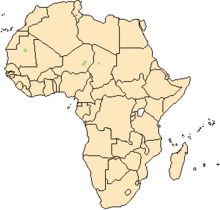Addax
| Addax | |
|---|---|
 |
|
| Addax in Morocco | |
| Scientific classification | |
| Kingdom: | Animalia |
| Phylum: | Chordata |
| Class: | Mammalia |
| Order: | Artiodactyla |
| Family: | Bovidae |
| Subfamily: | Hippotraginae |
| Genus: |
Addax Laurillard, 1841 |
| Species: | A. nasomaculatus |
| Binomial name | |
|
Addax nasomaculatus (de Blainville, 1816) |
|
 |
|
| Distribution of addax (IUCN 2015)
Extant (resident)
Reintroduced
|
|
| Synonyms | |
|
List
|
|
The addax (Addax nasomaculatus), also known as the white antelope and the screwhorn antelope, is an antelope of the genus Addax, that lives in the Sahara desert. It was first described by Henri de Blainville in 1816. As suggested by its alternative name, this pale antelope has long, twisted horns - typically 55 to 80 cm (22 to 31 in) in females and 70 to 85 cm (28 to 33 in) in males. Males stand from 105 to 115 cm (41 to 45 in) at the shoulder, with females at 95 to 110 cm (37 to 43 in). They are sexually dimorphic, as the females are smaller than males. The colour of the coat depends on the season - in the winter, it is greyish-brown with white hindquarters and legs, and long, brown hair on the head, neck, and shoulders; in the summer, the coat turns almost completely white or sandy blonde.
The addax mainly eats grasses and leaves of any available shrubs, leguminous herbs and bushes. These animals are well-adapted to exist in their desert habitat, as they can live without water for long periods of time. Addax form herds of five to 20 members, consisting of both males and females. They are led by the oldest female. Due to its slow movements, the antelope is an easy target for its predators: lions, humans, African hunting dogs, cheetahs and leopards. Breeding season is at its peak during winter and early spring. The natural habitat of the addax are arid regions, semideserts and sandy and stony deserts.
The addax is a critically endangered species of antelope, as classified by the IUCN. Although extremely rare in its native habitat due to unregulated hunting, it is quite common in captivity. The addax was once abundant in North Africa, native to Chad, Mauritania and Niger. It is extinct in Algeria, Egypt, Libya, Sudan and Western Sahara. It has been reintroduced in Morocco and Tunisia.
The scientific name of the addax is Addax nasomaculatus. This antelope was first described by French zoologist and anatomist Henri Blainville in 1816. It is placed in the monotypic genus Addax and family Bovidae. Henri Blainville observed syntypes in Bullock's Pantherion and the Museum of the Royal College of Surgeons. English naturalist Richard Lydekker stated their type locality to be probably Senegambia, though he did not have anything to support the claim. Finally, from a discussion in 1898, it became more probable that British hunters or collectors obtained the addax from the part of Sahara in Tunisia.
...
Wikipedia

